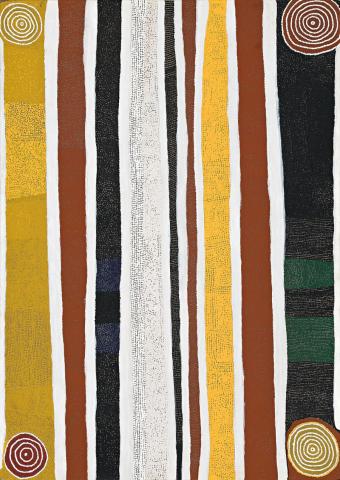THE KINGFISHER ANCESTRAL SPIRIT'S TRAVELS IN THE ARTIST'S COUNTRY, 1990
MURTIYARRU SUNFLY TJAMPITJIN
synthetic polymer paint on canvas
119.5 x 84.5 cm
inscribed verso: artist’s name, size and Warlayirti Artists cat. 482/90
Warlayirti Artists, Balgo Hills
Gallery Gabrielle Pizzi, Melbourne, 1990
Private collection, Melbourne
Innovation and Tradition: an exhibition of recent paintings by Warlayirti Artists from Balgo Hills, WA, Gallery Gabrielle Pizzi, Melbourne, November 1990 (label attached verso)
Cross Roads - Towards a New Reality: Aboriginal Art from Australia, The National Museum of Modern Art, Kyoto, 22 September - 8 November 1992; The National Museum of Modern Art, Tokyo, 17 November - 20 December 1992, cat. 75
Uchiyama, T. (ed.), Cross Roads - Towards a New Reality: Aboriginal Art from Australia, The National Museum of Modern Art, Kyoto, 1992, p. 107 (illus.)
Murtiyarru Sunfly Tjampitjin belongs to the first generation of male artists to emerge from the ex-mission settlement of Wirrimanu, or Balgo, in Western Australia. Encircled by the plains of the Tanami and Great Sandy deserts, the uniqueness of the community is in part a result of the diverse language groups represented amongst its members. Each culturally diverse, the traditions of the seven language groups have resulted in a social and creative pluralism unlike other desert location, with the exception of Papunya in the early 1970s.
It was from this extraordinary meld that the first decade (from 1981 - 1992) of the Balgo painting movement emerged, in part heralded by the land rights movement of the previous decade.1 Functioning as documents which asserted their custodianship of major ceremonies and tracts of land, the 'genius of Wirrimanu art emerged in all its bold opulence: a broad calligraphic style combined with linear techniques of dotting and lush surfaces, together evoking depths of land and being...Often appearing more as a collection of individual or family renditions of Tjurrpa (Dreaming) and sites, Wirrimanu's 'style' is one of conjunction, experimentation and expressiveness.'2
It was within this context that the work of Tjampitjin flourished. Developing a complex language for the translation of traditional designs onto canvas, by the turn of the century he was considered one of the region’s major contemporary artists.
The Kingfisher Ancestral Spirit’s Travels in the Artist’s Country 1990 is a major painting from the early stage of the artist’s short career. The Artist’s Country, as cited in the title of the work, incorporates features related to the mythical Tingari creation beings and documents Luurnpa, the Kingfisher’s journey between waterholes, which are expressed here as roundels.
The confidence with which Sunfly Tjampitjin depicted this site is astonishing and attests to his great cultural knowledge. Rows of broad vertical bands of strong colour are separated by parallel lines of white and the work is framed at each corner by roundels. In this painting, changes of colour portray variations in scrub and vegetation. The pathways of the Kingfisher are dramatised by the use of lines of white dots, which appear to vibrate and oscillate on the surface of the canvas.
Sunfly’s work is classic in its minimalist perfection, balancing large icons with fine detail to create monumental effects within moderately sized canvases. It is measured, and restrained, and imparts an unfailing atmosphere of authority.
1. the Kimberley Land Council, which serviced the Wirrimanu area, was formed in 1978 (see McDonald, H., Blood, Bones and Spirit: Aboriginal Christianity in an East Kimberley Town, Melbourne University Press, Melbourne, 2002, p. 89)
2. Watson, C., in Perkins, H., One Sun, One Moon, Aboriginal Art in Australia, Art Gallery of New South Wales, 2007, p. 219
